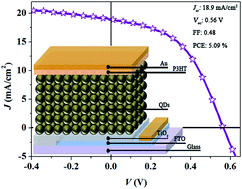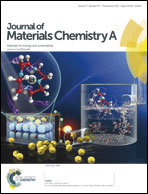Slow recombination in quantum dot solid solar cell using p–i–n architecture with organic p-type hole transport material†
Abstract
The interfaces between different materials in the heterojunction colloidal quantum dot (QD) solar cell play an important role for charge carrier separation, recombination and collection. Here, an organic–inorganic hybrid p–i–n architecture for the heterojunction PbS QD solid solar cell is constructed to increase the charge extraction and reduce charge recombination. Heavily doped poly(3-hexylthiophene-2,5-diyl) (P3HT) is applied as hole transport interlayer between the QD film and metal contact electrode. The results show that the P3HT interlayer diminishes the charge carrier recombination at the QD film/metal contact electrode interface leading to increased open-circuit voltage and increased electron life time. Furthermore, after incorporation of P3HT interlayer an additional p–i heterojunction might form at P3HT/QD film interface resulting in increased depletion region, which promotes charge carrier extraction under working conditions. Two other organic p-type interlayers are also investigated, however, the results indicate that a barrier for charge extraction is formed for these devices, which is explained by the difference in energy levels. The solar cell with the P3HT interlayer exhibits a power conversion efficiency of 5.1% at 1 sun of illumination and ambient atmosphere, which is ∼20% higher compared to the solar cell without any hole transport interlayer.


 Please wait while we load your content...
Please wait while we load your content...